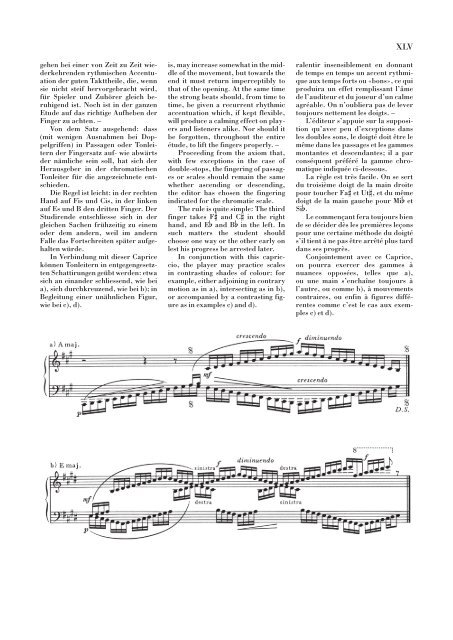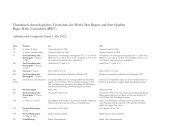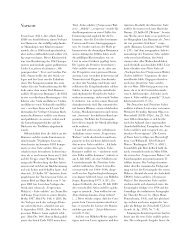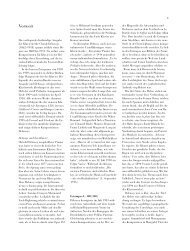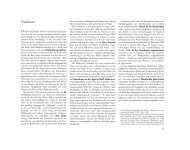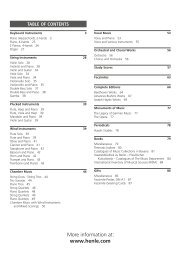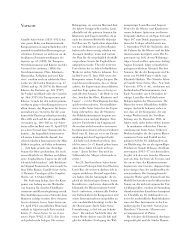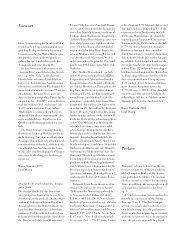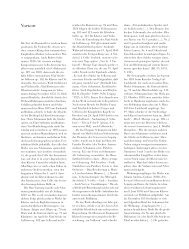Vorwort (PDF, 1698 KB) - Henle Verlag
Vorwort (PDF, 1698 KB) - Henle Verlag
Vorwort (PDF, 1698 KB) - Henle Verlag
You also want an ePaper? Increase the reach of your titles
YUMPU automatically turns print PDFs into web optimized ePapers that Google loves.
gehen bei einer von Zeit zu Zeit wiederkehrenden<br />
rythmischen Accentuation<br />
der guten Takttheile, die, wenn<br />
sie nicht steif hervorgebracht wird,<br />
für Spieler und Zuhörer gleich beruhigend<br />
ist. Noch ist in der ganzen<br />
Etude auf das richtige Aufheben der<br />
Finger zu achten. –<br />
Von dem Satz ausgehend: dass<br />
(mit wenigen Ausnahmen bei Doppelgriffen)<br />
in Passagen oder Tonleitern<br />
der Fingersatz auf- wie abwärts<br />
der nämliche sein soll, hat sich der<br />
Herausgeber in der chromatischen<br />
Tonleiter für die angezeichnete entschieden.<br />
Die Regel ist leicht: in der rechten<br />
Hand auf Fis und Cis, in der linken<br />
auf Es und B den dritten Finger. Der<br />
Studirende entschliesse sich in der<br />
gleichen Sachen frühzeitig zu einem<br />
oder dem andern, weil im andern<br />
Falle das Fortschreiten später aufgehalten<br />
würde.<br />
In Verbindung mit dieser Caprice<br />
können Tonleitern in entgegengesetzten<br />
Schattirungen geübt werden: etwa<br />
sich an einander schliessend, wie bei<br />
a), sich durchkreuzend, wie bei b); in<br />
Begleitung einer unähnlichen Figur,<br />
wie bei c), d).<br />
is, may increase somewhat in the middle<br />
of the movement, but towards the<br />
end it must return imperceptibly to<br />
that of the opening. At the same time<br />
the strong beats should, from time to<br />
time, be given a recurrent rhythmic<br />
accentuation which, if kept flexible,<br />
will produce a calming effect on players<br />
and listeners alike. Nor should it<br />
be forgotten, throughout the entire<br />
étude, to lift the fingers properly. –<br />
Proceeding from the axiom that,<br />
with few exceptions in the case of<br />
double-stops, the fingering of passages<br />
or scales should remain the same<br />
whether ascending or descending,<br />
the editor has chosen the fingering<br />
indicated for the chromatic scale.<br />
The rule is quite simple: The third<br />
finger takes F and C in the right<br />
hand, and E and B in the left. In<br />
such matters the student should<br />
choose one way or the other early on<br />
lest his progress be arrested later.<br />
In conjunction with this capriccio,<br />
the player may practice scales<br />
in contrasting shades of colour: for<br />
example, either adjoining in contrary<br />
motion as in a), intersecting as in b),<br />
or accompanied by a contrasting figure<br />
as in examples c) and d).<br />
XLV<br />
ralentir insensiblement en donnant<br />
de temps en temps un accent rythmique<br />
aux temps forts ou «bons», ce qui<br />
produira un effet remplissant l’âme<br />
de l’auditeur et du joueur d’un calme<br />
agréable. On n’oubliera pas de lever<br />
toujours nettement les doigts. –<br />
L’éditeur s’appuie sur la supposition<br />
qu’avec peu d’exceptions dans<br />
les doubles sons, le doigté doit être le<br />
même dans les passages et les gammes<br />
montantes et descendantes; il a par<br />
conséquent préféré la gamme chromatique<br />
indiquée ci-dessous.<br />
La règle est très facile. On se sert<br />
du troisième doigt de la main droite<br />
pour toucher Fa et Ut, et du même<br />
doigt de la main gauche pour Mi et<br />
Si.<br />
Le commençant fera toujours bien<br />
de se décider dès les premières leçons<br />
pour une certaine méthode du doigté<br />
s’il tient à ne pas être arrêté plus tard<br />
dans ses progrès.<br />
Conjointement avec ce Caprice,<br />
on pourra exercer des gammes à<br />
nuances opposées, telles que a),<br />
ou une main s’enchaîne toujours à<br />
l’autre, ou comme b), à mouvements<br />
contraires, ou enfin à figures différentes<br />
comme c’est le cas aux exemples<br />
c) et d).


